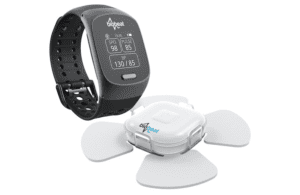
Remote patient monitoring technology from Biobeat can detect 14 cardio-pulmonary vital sign measurements. A number of pharma companies and contract research organizations are implementing the technology. Image courtesy of Biobeat.
Remote patient monitoring (RPM) is among the trends that will have the greatest impact on the pharma sector in 2021, according to the recent report, “The State of the Biopharmaceutical Industry, 2021 Edition,” from GlobalData. After a period of gradual uptake, RPM “witnessed a massive uptake in the life-sciences sector in 2020,” according to the GlobalData report.
The technology offers several advantages. It can help pharmaceutical companies continue making progress with clinical trials during a pandemic. The ability to gather data from patients remotely can also reduce the burden on medical staff while reducing gaps in clinical trial data. “One of the advantages when you have frequent measurements from remote patient monitoring is that, even if you have missing data, you tend to have so many data points that it doesn’t interfere with your judgment,” said Dr. Arik Eisenkraft, chief medical officer of BioBeat.
Remote data gathering for COVID-19 and vaccines
Remote patient monitoring can also help researchers better understand COVID-19 and other viral infections. Data from wearable devices can detect physiological changes in the early stages of viral infections, according to a 2020 article published in The Lancet.
“We were involved in two different flu studies, and definitely you can see physiological changes, using wearable technology in people who got the flu,” Eisenkraft said. “You sometimes see dramatic changes between men and women” in response to influenza-like illness, he added. “We’ve seen some dramatic cardiovascular changes among these patients far earlier than anyone would have thought — sometimes even before you see any respiratory changes.”
Remote patient monitoring can also shed light on potential adverse events from COVID-19 vaccines. Vital signs gathered via wearable technology can establish a baseline before a patient receives an initial vaccine dose, Eisenkraft said. After the baseline is established, clinical trials can identify the effect of the prime and boost vaccine doses.
Remote trials tend to be more patient-centric
Decentralized clinical studies not only help reduce COVID-19 transmission, but they also happen to be more convenient for patients. The benefits of remote clinical trials are especially high when it comes to chronic diseases such as congestive heart failure, diabetes and hypertension. Even before the pandemic, one of the top clinical trial hurdles in monitoring these diseases and drugs related to them was an inconvenience for patients. “And because a clinic is not a patient’s natural environment, it can make it difficult to measure the effects of drugs,” Eisenkraft said.
For instance, physicians have long known about white coat hypertension, a phenomenon in which some patients’ blood pressure rises when in a doctor’s office.
“Another aspect with remote patient monitoring is the fact you might find things you didn’t expect because you have so much data,” Eisenkraft said. One example is discovering clinically significant hypertension during dialysis. “We have an early warning score that triggers an alert if something goes wrong during dialysis,” Eisenkraft said. Finding such problems in the past was difficult given that measurements were usually collected before or after dialysis.
Ultimately, similar alerts can be applied for an array of physiological parameters in pharmaceutical clinical trials, Eisenkraft said. Data from wearable devices can help researchers understand how a given drug performs in specific patient populations. It’s even possible that physiological monitoring can lead to custom instructions for patients taking a particular drug. “Some patients with high blood pressure benefit more if they take a hypertension drug at night while others fare better when taking it in the morning,” Eisenkraft said.
Wearable device data could accelerate the detection of troubling signals from drugs during clinical trials and post-marketing surveillance.
The potential to provide medically relevant alerts continues to grow, thanks to increasing machine learning adoption (ML). “Artificial intelligence enables us to update algorithms and provide continually better monitoring,” Eisenkraft said. “Especially when you’re looking at large scale studies, this can be a huge advantage when you need to analyze so many data points.” Even in small studies, Biobeat gathers several million data points throughout a trial. “You really need to use AI/ML systems and tools to analyze everything,” Eisenkraft said.